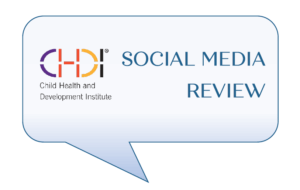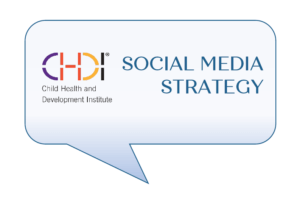The Project
In 2022, my clients* at the Child Health & Development Institute (CHDI), a nonprofit working to improve children’s behavioral health at the systems, policy, and practice levels, already had a solid overall communications strategy that provided a high-level overview of their goals, key audiences, and messages. But when it came to social media, they told me they often felt like they were winging it – a common sentiment for many busy nonprofits, especially those like CHDI with a communications “department” of one. They were seeking guidance to ensure that their social media efforts were as strategic as the rest of their communications work. That’s where I came in!
Phase 1: Social Media review (AUDIT)

The first phase of the strategy process is to conduct a comprehensive social media review (sometimes called an audit). This critical step enables us to take stock of an organization’s current social media efforts, assess what is working well and what could be stronger, identify gaps and opportunities, and inform the development of a strategic social media plan that is aligned with and furthers the organization’s goals.
CHDI’s social media review involved the following steps:
- Reviewing the organization’s social media analytics and metrics over the past 3 years, with a closer look at analytics from the past year
- Reviewing the organization’s strategic plan and overall communications strategy to gauge whether current social media efforts were strategically aligned with overall goals
- A deep dive into posts, engagement, and audiences on each of CHDI’s social media accounts (which included Twitter, LinkedIn, and Facebook at that time) to identify the best-performing content, as well as assess details such as tone, responses to comments, % of posts related to equity or disparities (which the org had identified as a major priority), best days and times to post, accessibility concerns, etc.
- Assessing the CHDI leadership team’s current social media presence
- Revisiting the results of a recent audience survey on communications conducted by the organization about key audiences’ content interests and preferences
- Conducting a basic competitor analysis to gauge how CHDI’s social media presence compared to similar organizations
- Assessing the organization’s current resources and capacity to support social media efforts
- Multiple conversations with CHDI’s VP of Communications to help me better understand key audiences and goals.
After the review, I put together a written report summarizing my findings and recommendations. The review revealed that CHDI was already performing well on social media, seeing slow but steady follower growth and engagement, posting relevant content targeting key audiences, and focusing on key messages.
However, I also identified areas where they had room to grow, refine, and improve. My recommendations included several general suggestions that applied to social media efforts overall, specific recommendations to enhance their presence on each platform, and a new platform to consider due to their target audiences and subject matter, such as:
- Posting on a more consistent schedule
- Engaging leadership team and staff as social media ambassadors (particularly on LinkedIn) to boost reach and engagement
- Training senior leadership on using social media for thought leadership
- Increasing social media promotion of major publications and reports
- Repurposing great content from website and email newsletter for social media
- Creating branded, professionally designed social media graphic templates
- Increasing use of short videos and less formal content to increase audience engagement
- Significantly increasing percentage of posts related to anti-racism and equity issues that intersect with children’s behavioral health, in alignment with CHDI’s stated values and goals
- Tailoring content for each platform to the extent possible using social media management software
- Considering experimenting with Instagram due to potential for engaging two key audiences (educators and behavioral health providers/therapists)
CHDI’s VP of Communications and I reviewed these recommendations together, then I used it to craft an updated, practical social media strategy for the upcoming year.
Phase 2: a PRACTICAL Strategy

The strategy I created included:
- Audience personas representing the organization’s key audiences to help create more targeted content (which could also be used for overall communications efforts)
- Core content pillars
- 1- and 3-year measurable objectives and goals
- Brief plan for growing each specific platform, including an overview of key audiences, personas, objectives, and specific, strategic content ideas for each
- Monthly social media calendar
- Tips to keep the strategy alive throughout the year
- Excel workbook with brief overview of social media metrics, personas, and content pillars for quick reference
Phase 3: IMPLEMENTATION
After CHDI approved the new social media strategy, it was time to put it to use. To increase their capacity, the organization continued their contract with me to support content development and help manage the social media calendar. I created graphic templates in Canva and delivered a training with senior staff on using social media for thought leadership and to amplify the organization’s presence. I also got to work using Canva to create simple brief videos and carousels highlighting major publications and programs. They decided to move forward with starting an Instagram account, so I put together a simple launch plan.
Phase 4: RESULTS and REFINEMENT
After one year of implementing the new social media strategy, I compiled the metrics and created an annual social media report to review with the organization. Compared to the previous year, between 2022-23 CHDI saw the following results:
- Total social media impressions: 52%+
- Average follower growth: 27%+ (nearly all of whom belonged to a key/target audience)
- Engagement rates across all platforms were maintained or increased, above nonprofit industry averages
- Percentage of posts related to equity and anti-racism issues (tied to CHDI’s mission) increased from ~5% to over 20%
- CHDI website traffic increased ~29%, driven in part by increased social media activity
- Several senior leadership staff also significantly grew their LinkedIn followers, began posting more consistently, and increased engagement on their posts, helping to position themselves and CHDI as thought leaders.
These results far exceeded their average annual growth and performance in previous years, demonstrating that we were on the right track!
*I began working with CHDI as a consultant and freelancer in 2022 before being invited to join the staff in 2023.

